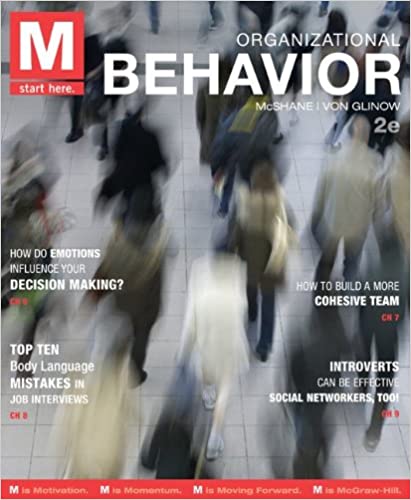
M: Organizational Behavior 2nd Edition by Steven McShane, Mary Von Glinow
Edition 2ISBN: 978-0077801960
M: Organizational Behavior 2nd Edition by Steven McShane, Mary Von Glinow
Edition 2ISBN: 978-0077801960 Exercise 19
Instructions
Step 1: The class is organized around three, six, or nine tables, depending on class size. Classes up to about 36 students can have three large tables. Classes with up to about 72 students would have six tables, and larger classes would have nine tables. Tables should be sufficiently apart (may be in different breakout rooms) for comfortable conversation among people at each table.
Step 2: Each table is permanently assigned one of the three world café topics listed below. If the class has six or nine tables, then two or three tables would have the same topic.
Step 3: Students are randomly organized into three, six, or nine groups (equal to the number of tables), and initially assigned to one of the tables. One student in each group volunteers to be the "scribe" for that table. She or he will remain at that table throughout the world café exercise. The scribe will document the main ideas discussed at that table and will later facilitate debriefing of that world café topic with the entire class.
Step 4: Groups are given a fixed time (usually 10-20 minutes) to discuss their particular topic. At the end of that time, each group moves to another table assigned one of the other two topics. The scribe remains at the first table and documents discussion of the arriving second group. Although the scribe can encourage discussion, he/she should allow each group to talk freely even if the conversation repeats what the previous group discussed.
Step 5: After a fixed time, groups move for a third time to a table with the third topic. Again, scribes remain at their original tables and document discussion of the arriving third group.
Step 6: After the third round of discussion, the class reconvenes and scribes are asked to briefly summarize the key discussion points from their table. Scribes should invite a few students to repeat ideas they mentioned at the table.
World Café Table Discussion Topics (One topic for each table)

Step 1: The class is organized around three, six, or nine tables, depending on class size. Classes up to about 36 students can have three large tables. Classes with up to about 72 students would have six tables, and larger classes would have nine tables. Tables should be sufficiently apart (may be in different breakout rooms) for comfortable conversation among people at each table.
Step 2: Each table is permanently assigned one of the three world café topics listed below. If the class has six or nine tables, then two or three tables would have the same topic.
Step 3: Students are randomly organized into three, six, or nine groups (equal to the number of tables), and initially assigned to one of the tables. One student in each group volunteers to be the "scribe" for that table. She or he will remain at that table throughout the world café exercise. The scribe will document the main ideas discussed at that table and will later facilitate debriefing of that world café topic with the entire class.
Step 4: Groups are given a fixed time (usually 10-20 minutes) to discuss their particular topic. At the end of that time, each group moves to another table assigned one of the other two topics. The scribe remains at the first table and documents discussion of the arriving second group. Although the scribe can encourage discussion, he/she should allow each group to talk freely even if the conversation repeats what the previous group discussed.
Step 5: After a fixed time, groups move for a third time to a table with the third topic. Again, scribes remain at their original tables and document discussion of the arriving third group.
Step 6: After the third round of discussion, the class reconvenes and scribes are asked to briefly summarize the key discussion points from their table. Scribes should invite a few students to repeat ideas they mentioned at the table.
World Café Table Discussion Topics (One topic for each table)

Explanation
Comments for Instructors
World cafés pro...
M: Organizational Behavior 2nd Edition by Steven McShane, Mary Von Glinow
Why don’t you like this exercise?
Other Minimum 8 character and maximum 255 character
Character 255


